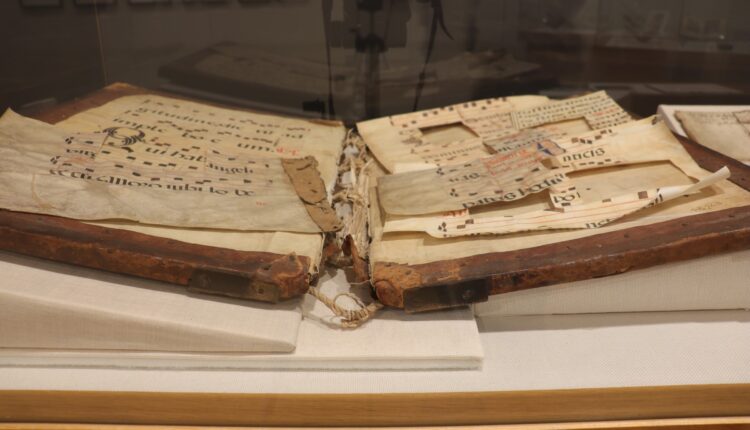Ohio State University Puts Rare Medieval Manuscript Pages On Display
Ohio is home to a large number of fragments from medieval books, a rarity for the Midwest. Eric Johnson, professor and curator of Thompson Special Collections at The Ohio State University, said Ohio has more manuscript pages per capita than anywhere else in the United States.
“That’s a very odd thing for a Midwestern state,” Johnson said. “The major reason for this comes down to two men: Otto Ege and Bruce Ferrini.”
Ege and Ferrini spent decades in the 20th century finding medieval manuscripts and then breaking them so that the individual pieces could be sold. It is this legacy of book breaking and Ohio’s role in it that is the focus of a new exhibition in Thompson Library, Deathless Fragments.
The title of the show comes from a contact of Ege’s, Johnson said. While Ferrini’s sales were mostly for profit, Ege wanted to make these manuscript pages available to the masses. Beginning in the 1930s, he worked with the Lima public library system to sell the pages as a fundraiser. Georgie McCaffee was head of the library and worked with Ege to sell hundreds of what she called “deathless fragments.”
“These are all remnants of books that were produced for specific purposes, readers and uses back in the 11th, 12th, through the 15th centuries,” Johnson said. “But that’s not the end of their story. They’ve all persisted through time and have continued to have very real cultural and educational relevance today.”
Not only does Ohio State have a voluminous collection of pages – between 1,400 and 1,500, Johnson said – but some of these pages are also from books like the Beauvais Missal and the Hornby-Cockerell Bible, two famous manuscripts.
Johnson’s team is working to reassemble the Hornby-Cockerell Bible.
“We have close to 200 leaves from that,” Johnson said. The manuscript is 440 pages long. Johnson has discovered another 40 or 50 at other institutions, which can be added to the university’s pieces remotely via digital technology.
“We’re in a position where we can reconstruct these pieces digitally,” he said. “There are numerous reconstruction projects happening for manuscripts all over the world. The quality, the size, the breadth, the depth of Ohio State’s fragment collection means that we are a linchpin collection for this work.”
Given Ohio’s role in book breaking, Johnson believes it is the university’s responsibility to aid in reconstruction work whenever possible.
“We are a public institution and, given Ohio’s major role in book destruction and the dispersal of medieval manuscripts, it makes sense that Ohio State be a local focal point for reconstruction efforts.”
Between these two acts, the destruction and the reconstruction of a book, there is a wealth of educational opportunities, Johnson said.
“So much work can happen between these two points,” he said. “Students help with these efforts. We’ve had undergraduates, honors students, individual studies and graduate students – they adopt these fragments for their work.”
“There is the romanticism of rebuilding these things and recovering a lost past and undoing deliberate damage that has been done to truly historically significant objects,” Johnson said. “But more so, there is an educational power in these artifacts when placed in the hands of students who are empowered to work with them.”Manuscripts from ‘Deathless Fragments’
Manuscripts from ‘Deathless Fragments’
Students are not the only ones who benefit from exposure to objects like these. Johnson developed the exhibition with hopes that the public will find them every bit as educational and fascinating.
“These things are accessible. These things are usable. These things are here for the citizenry of Ohio. This is not material you need to be a professor of history or English to enjoy,” he said. “This is not something where you have to be an enrolled student at Ohio State. This is the property of the state of Ohio. This is here for everyone.”

